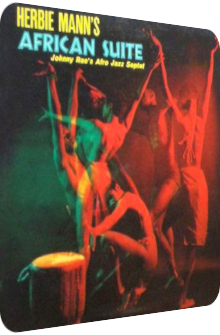
Herbie Mann
African Suite
1959
African Suite by Jazz flutist and clarinetist Herbert Jay Solomon (1930–2003) – better known under his stage name Herbie Mann and as being part of the New York Jazz Quartet (known for their 1957 take on Exotica called Gone Native) – is a seven-track album released in 1959 on United Artists Records, comprising of long-form renditions and unique pieces written by Mann himself. Aided by the Afro-Jazz Septet led by vibraphonist and percussionist Johnny Rae (born 1934), the album is indeed exotic and supercharged with Latin percussion, bongos and congas en masse, moist marimba melodies and polyhedric piano prongs.
Two things, however, prevent me as a reviewer to place the album in the nucleus of the Exotica genre: firstly, the tone sequences are adamantly jazzy and complex, and it is up for the textures to enchant the listener, with the occasional segue of carved out singalong melodies serving as a delightful counterpoint. Secondly, the approach of Herbie Mann is playful, don’t get me wrong, but rather dedicated and serious. He does not specifically target the – back then – ever-growing amount of tikiphiles and bachelor pad inhabitants, but focuses on the globetrotting Jazz connoisseur. The groove is more important than the majesty of the melody. To me, however, African Suite remains a bold Exotica classic. This is accomplished through the wild amount of textures and, most importantly, the frantic drum solos and intersections that are scattered all over the LP. Side A features one Mann track and two renditions, one of them of an Exotica quasi-classic, whereas side B is reserved for the actual African Suite, a collection of four different but incessantly beautiful formations. Call it world music, ethnic ayres or, in a probably audacious move, Exotica, for whatever the applied label might be, Herbie Mann, Johnny Rae and fellows are certainly covering your personal taste as well.
Herbie Mann’s African Suite starts in the Caribbean. Yes, that’s true. St. Thomas is a long-form piece of over eight minutes, dedicated to the eponymous island, but refrains from injecting all too obvious globs of clichés into the scenery. Originally envisioned by Sonny Rollins in 1956, you will not hear one single steel pan, but the uplifting vibe is still very Calypsonian. Launching with muffled cymbals and gorgeous bongo and conga layers, the interpretation soon moves forward to good-natured paradisal flute melodies as unleashed by Herbie Mann himself, followed by Johnny Rae’s double bass-accentuated vibraphone spirals which twirl and tumble seemingly ad infinitum. The simultaneity of the moods and temperatures is exciting throughout the piece; for instance, all the while Rae is delivering his eclectic vibe aortas, sun-dappled piano tercets warm up their soothing chill.
St. Thomas is delivered in five parts here, although one does not notice this immediately. The first part features Herbie Mann’s flute in the spotlight, the second part is keen on Johnny Rae’s vibes, with the third part being reserved for the pianist, the fourth for the bassist, and the fifth one consisting of an eclectic drum solo by Johnny Rae. St. Thomas is thus like a pearl necklace where each pearl resembles one instrument in the spotlight. Melodious parts, savage contraventions and benign segues are all in here. The upper tempo regions make it highly compatible for workout sessions.
Sorimao follows, written by Mann himself. Clever marketing has it that the title is based on an artificial word that will forever be linked to the flutist. Instead of an alto flute, however, Mann unchains his bass clarinet whose deep arcana throne above the clanging drums and hollow bongo serpentines, only partially illumined by Rae’s vibes. Rhythm shifts and pointillistic vibe flecks form great counterparts to the prolonged danger-evoking timbre of the clarinet. Side A closes with another merciless long-form piece which is a take on Esy Morales’ Jungle Fantasy. Often considered in Exotica climes – for example by Frank Hunter on White Goddess (1959) and Arthur Lyman on Taboo 2 (1960) – and fostering semi-serious tachycardia levels, Herbie Mann does the composition more than enough justice by featuring cavalcades of segues and a frantic tempo mania. The rather famous five-note anacrusis shrouded in cheeky mystery is played on the flute and echoed on the vibraphone.
Conga and bongo fans have a field day here as well, everything rushes by in a jocular frenzy, the tone sequences are convoluted yet accessible and even hummable. Rest assured that a sophisticated drum solo is mandatory and therefore integrated in the middle of the track, lasting for more than three minutes! Another ingredient worth mentioning is the iridescent piano. The chords appear less frequently, but whenever they do, a soft solemnity is delivered. Not much melodrama is needed anyway, for the upheaval in the foreground is more than enough to keep anyone’s heart going. Structured with fissures and clefts, Mann’s take on Jungle Fantasy transforms it to a delicate free-form piece. Yes, it could have been much shorter, but other Exotica luminaries have already interpreted it this way, so this is, if you will, one truly special rendition.
Side B is another specialty in that it only features unique material, all written by Herbie Mann. This is the actual African Suite comprising of four parts. Bedouin is my favorite track of the bunch due to its genuinely exotic flute coils, the triangle-backed bongo shrubbery which is always in the foreground, and last but by far not least, Johnny Rae’s superb dark-green marimba billows which later turn into pristinely echoey droplets. This is a wonderful composition, very jungular and desert-like at the same time. Fans of this truthful approach, which is much more humble than the frilly-flamboyant Exotica genre makes you believe, should check out Tony Scott’s African Bird: Come Back! Mother Africa (1984) which delivers this purity and marries it with the wide steppes and deserts of Africa.
The follow-up Sudan sees Johnny Rae’s marimba and Herbie Mann’s Pagan flute reunited, now in a slower midtempo number backed by snake-like shakers and the occasional Mediterranean marimba section. A very soothing and contemplative track, mountainous yet earthbound on sea level. Exunda then interweaves mirthful marimba droplets with large-grained maracas, bongos and an alto flute. Flute and marimba are mostly attached to each other. By playing the melody in tandem, the two luminaries create an exotic polyphony. Of further note is the wonderful bongo and boo-bam solo in the middle. The finale is called Guinean and sees Mann revving up both the tempo and the luminosity of the percussion side by adding brazen instruments to the pool. Here, Rae’s marimba is again strikingly jungle-evoking and almost surprisingly similar to steel pans tonality-wise. The flute tones seem to be freer and less attached to a definite motif, a curious remark, for this freedom does not lead to labyrinthine tones, but remains designedly attached to the drum aorta.
African Suite is a delightful Afro Bop-infused Jazz album with distillable Exotica traces. In the end, however, it sports a more faithful approach that may at times circumvent the needs of the devoted genre fan. Herbie Mann and Johnny Rae did not approach this project from a musicology angle, which implies that the album is still freely flowing and comprising of imaginative segues and ideas. But the over-the-top extravaganza of Exotica with choirs, multitudes of new instruments on each take or other tidbits is not in the focus of Mann. And it is not necessary at all, for the two main instruments are wonderfully compatible and cleverly chosen: Mann’s flute (and bass clarinet) as well as Rae’s vibraphone (and marimba on side B) work well in tandem. The septet knows how to add fiery backdrops to the jungular sceneries, with the piano chords oscillating between mystique, gaseous states and sunset bursts, all the while the gorgeously detailed percussion and rhythm waves add much to the already alluvial soils.
Mann’s own concoctions are always delightful, with the ardent Bedouin being an essential ayre, but it is other people’s material he turns into something crazily detailed: Rollins’ St. Thomas is augmented by a camouflaged five-part movement tied to the respective instrument in the spotlight, whereas Morales’ Jungle Fantasy is stretched by a long percussion solo in the middle. African Suite is complex, often even labyrinthine, but skillful Exotica listeners – no insult intended, no exclusion implied! – who are right at home in the world of Jazz will get the most out of the instrumental interdependencies. Fans of the aforementioned New York Jazz Quartet’s Gone Native will also dig the carefree spirit that made it to African Suite. Available on vinyl and a download version which is based on the 2011 CD reissue that couples African Suite with material by the Herbie Mann Nonet.
Exotica Review 310: Herbie Mann – African Suite (1959). Originally published on Feb. 1, 2014 at AmbientExotica.com.
